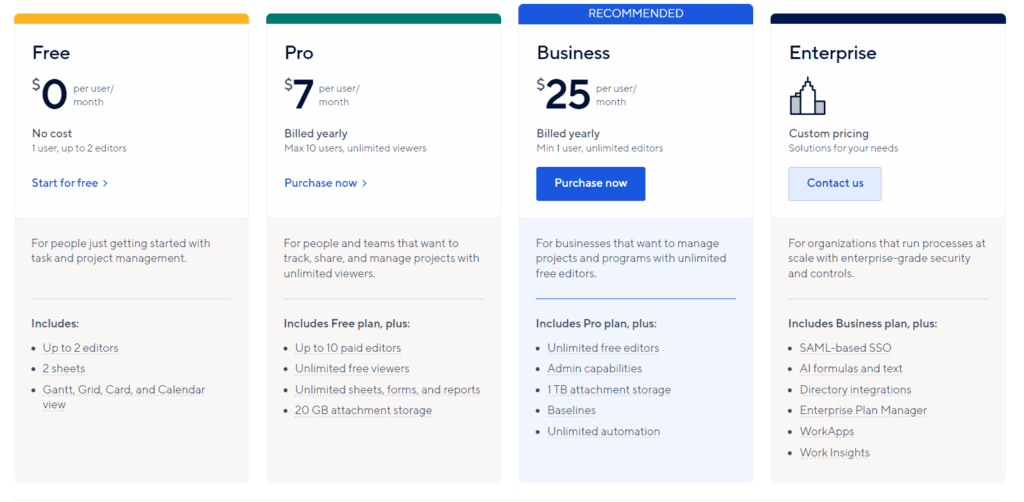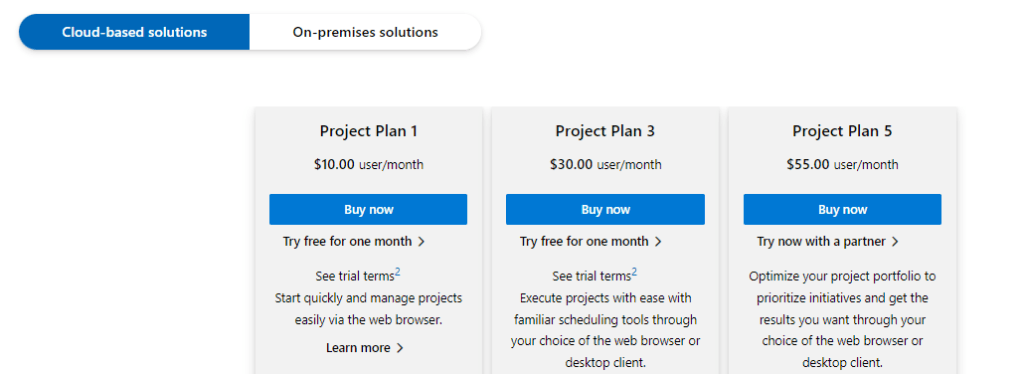In the bustling world of project management, the quest for the perfect tool can feel like an epic journey. There’s a vast sea of options, but today, we’re zooming in on two titans of the trade: Smartsheet and Microsoft Project. Each boasts its unique strengths, ready to be the linchpin of your project management strategy. But which one is the right fit for you? Is it Smartsheet, with its flexible, grid-based approach, or Microsoft Project, a stalwart with deep roots in the project management tradition? Our exploration begins at a critical crossroads – ease of use and user interface – because, in the end, the best tool is the one that feels less like wrestling a kraken and more like commanding a finely tuned ship.
Smartsheet | Microsoft Project |
|---|---|
| G2 Score – 4.4 out of 5 stars | G2 Score – 4 out of 5 stars |
| TrustRadius Score – 8/10 | TrustRadius Score – 7.6/10 |
Ease of Use and User Interface: Setting the Course
The journey of a thousand projects begins with a single click. How that click feels, looks, and responds can set the tone for everything that follows. Let’s navigate the waters of Smartsheet and Microsoft Project to see which offers the smoother sail.
Smartsheet: The Agile Navigator
Smartsheet greets users with an interface that’s as familiar as an old map – it looks and operates like a spreadsheet but is infused with powerful project management capabilities. This familiarity breeds ease of adoption, making it a friendly port for those already versed in spreadsheet navigation. But don’t be fooled by its simple appearance; Smartsheet’s capabilities run deep. Custom views, automated workflows, and rich collaboration tools lie just beneath the surface, ready to be harnessed by those willing to explore its depths.
However, the very simplicity that makes Smartsheet accessible can also be its siren song. New users may find themselves adrift in its more advanced features, like resource management and complex reporting, which require a captain’s knowledge to navigate effectively.
Microsoft Project: The Seasoned Voyager
Microsoft Project, on the other hand, is like a seasoned ship – complex and powerful, designed for those who speak the language of project management fluently. Its interface is packed with features that offer precise control over every aspect of your projects, from Gantt charts to detailed resource allocation. This tool doesn’t shy away from complexity; instead, it embraces it, offering robust functionality for those who need to chart intricate project courses.
The trade-off for this power is accessibility. New users may find Microsoft Project’s interface daunting, with its steep learning curve resembling a climb up the crow’s nest. But for those willing to invest the time to master its controls, Microsoft Project proves to be an invaluable ally in the quest for project management excellence.
Integration Capabilities: Sailing Smooth with Digital Allies
The ability of a project management tool to seamlessly connect with other software is akin to a ship’s compatibility with favorable winds—essential for a smooth voyage.
Smartsheet: The Versatile Connector
Smartsheet prides itself on its broad spectrum of integrations, serving as a versatile connector in the vast sea of digital tools. With built-in integrations for a variety of applications including Google Workspace, Microsoft Office 365, Salesforce, and even more specialized tools like Jira and Slack, Smartsheet ensures that teams can keep their favorite tools in the loop without leaving the Smartsheet interface.
Moreover, Smartsheet’s open API extends its integration capabilities even further, allowing for custom connections that can tailor the platform to fit unique workflows. Whether you’re syncing calendars, automating data transfers between CRM systems, or bridging communication platforms, Smartsheet offers the flexibility to create a cohesive digital ecosystem tailored to your project management needs.
Microsoft Project: The Deeply Embedded Navigator
Microsoft Project, leveraging its position within the vast Microsoft ecosystem, excels at integrations, especially with other Microsoft products. Its seamless connectivity with Microsoft Teams, OneDrive, SharePoint, and Power BI, for example, provides users with an integrated experience that enhances collaboration, data storage, and analytics within the familiar Microsoft environment.
While Microsoft Project’s integrations are heavily optimized for the Microsoft ecosystem, it also supports connections with other tools through third-party solutions and its API. This ensures that even teams not fully embedded in the Microsoft world can still benefit from Microsoft Project’s robust project management capabilities, albeit with potentially more setup and customization effort compared to Smartsheet’s broader range of direct integrations.

Related: Check out our free SEO suite

Project Complexity and Scale
Consider the size and complexity of the projects your team manages. Microsoft Project, with its detailed scheduling and resource management capabilities, might be better suited for large-scale projects with intricate dependencies. Smartsheet, with its flexibility and ease of use, could be more fitting for a wider range of project sizes, especially if rapid adaptation and cross-functional collaboration are frequently required.
Smartsheet:
Smartsheet excels in its versatility, offering a familiar spreadsheet-like interface that can be easily adapted to manage a wide array of projects, from the simplest to the more complex. Its flexibility is a standout feature, accommodating rapid changes and diverse project requirements without steep learning curves. This makes Smartsheet a preferred tool for teams that manage multiple project types and require the ability to customize their approach extensively.
Smartsheet operates with a design philosophy that emphasizes flexibility and ease of use, making it an appealing choice for a broad spectrum of projects. Its spreadsheet-like interface is immediately familiar to many users, reducing the initial learning curve and enabling teams to start managing their projects quickly. This familiarity is a boon for teams that handle a variety of project types, from simple task tracking to more complex endeavors involving numerous stakeholders and dependencies.
Smartsheet’s ability to adapt to different project scales comes from its extensive customization options, which allow teams to tweak the platform according to their specific project requirements. Whether it’s a small internal project or a large-scale operation involving external collaborators, Smartsheet’s flexible setup can be configured to match. However, this flexibility does not mean Smartsheet lacks depth. For projects that grow in complexity, Smartsheet supports advanced features like automated workflows, detailed reporting, and resource management, although leveraging these features to their fullest might require a deeper dive into the platform’s capabilities.
Microsoft Project:
Microsoft Project is tailored for managing large-scale and complex projects. Its comprehensive set of features supports detailed project planning, intricate scheduling, resource allocation, and budget tracking. The depth of functionality provided by Microsoft Project caters to organizations and teams that need to maintain tight control over every project detail, making it ideal for intricate projects with numerous dependencies and stakeholders.
Microsoft Project is designed with the needs of complex projects in mind. It offers a comprehensive suite of project management tools that allow for meticulous planning, scheduling, and tracking. Microsoft Project’s strength lies in its ability to provide project managers with detailed control over every aspect of their projects. This includes sophisticated resource allocation tools, critical path method analysis, and the ability to manage project budgets in conjunction with task scheduling. The platform is particularly well-suited for large projects with complex dependencies, where the ability to forecast project timelines, adjust schedules in response to changes, and anticipate resource needs is critical.
The depth of functionality offered by Microsoft Project makes it a powerful ally for project managers operating in environments where precision and control are paramount. However, the platform’s complexity, while a strength, also means that there is a significant learning curve. Teams new to Microsoft Project or those without specialized project management training may find it challenging to unlock the full potential of the tool without dedicated time for learning and adaptation.
Customization and Reporting
Both tools offer powerful customization and reporting features, but the approach and extent of these capabilities differ. Smartsheet’s highly customizable dashboards and reports can provide deep insights into project performance and are accessible to users of varying technical skills. Microsoft Project’s reporting features are extensive and deeply integrated with other Microsoft analytics tools, potentially offering a steeper learning curve but rewarding for those who can leverage them fully.
Smartsheet:
Smartsheet’s customization capabilities are extensive, allowing users to tailor the platform extensively to meet their project management needs. From custom fields and formulas within sheets to detailed reports and dashboards, Smartsheet enables teams to track and report on the metrics that matter most to them in a highly personalized way.
Smartsheet approaches customization with the flexibility inherent in its spreadsheet-like interface, offering a familiar baseline from which customization can extend into complex project management scenarios. Users can create custom fields to capture unique project data, use formulas for automated calculations, and set up conditional formatting to highlight critical path tasks, deadlines, or budget issues. This level of customization ensures that teams can mold the platform to reflect their project structures accurately, enhancing relevance and usability.
Beyond task and project structuring, Smartsheet allows for the development of custom dashboards and reports, which empower teams to compile and visualize the project data that matters most to them. Whether it’s tracking progress against milestones, assessing resource allocation, or monitoring budget expenditure, Smartsheet’s reporting capabilities provide a comprehensive view of project health, facilitating informed decision-making.
Microsoft Project:
Microsoft Project offers robust reporting features, enabling the generation of comprehensive project reports on progress, resource utilization, and financials. Integration with Power BI takes Microsoft Project’s reporting capabilities to another level, allowing for advanced data analysis and the creation of customizable dashboards, providing deep insights into project performance.
Microsoft Project, with its deep roots in project management, offers a robust environment for customization, particularly appealing to project managers who deal with complex projects requiring detailed planning and tracking. The platform enables users to define a wide range of project parameters, including task dependencies, durations, and resource assignments, with the granularity needed for precise project control. Customization extends to the ability to tailor schedules, adjust Gantt chart displays, and configure detailed resource management settings to reflect the unique aspects of each project.
Microsoft Project’s reporting functionality is equally robust, offering a variety of pre-built and custom report templates that can be fine-tuned to present the data in insightful ways. Users can generate detailed reports on project timelines, resource availability, and cost analysis, among other metrics, integrating seamlessly with other Microsoft tools for further data processing or presentation needs.
Pricing
Smartsheet:

Microsoft Project:

Conclusion
Concluding our exploration of Smartsheet versus Microsoft Project reveals a landscape where each tool offers distinct pathways to project management success, differentiated by their approach to user interface, integration capabilities, customization, reporting, and more. This journey underscores the importance of selecting a project management tool that not only aligns with the technical requirements of your projects but also resonates with the working style and capabilities of your team.
Smartsheet shines as a flexible, intuitive platform that leverages the familiarity of a spreadsheet interface, making it accessible for teams of various skill levels. It stands out for its adaptability, offering extensive customization options and a wide array of integration possibilities, which make it a versatile choice for managing a diverse portfolio of projects. Its strength in providing user-friendly customization and comprehensive reporting capabilities makes Smartsheet particularly appealing for teams seeking a balance between sophistication and simplicity in managing their projects.
On the other hand, Microsoft Project, with its deep-rooted project management capabilities, is designed for those who require detailed control over every aspect of their project planning and execution. It excels in managing complex projects, offering advanced features for scheduling, resource allocation, and budget tracking. The seamless integration within the Microsoft ecosystem enhances its appeal for teams already invested in Microsoft products, providing a cohesive and powerful tool for detailed project management. However, the richness of its features comes with a steeper learning curve, making it more suited for users with a solid understanding of project management principles.
Read Next:
- Aritic Mail vs Mad Mimi: The Best Email Marketing Tool for You
- VerticalResponse vs Iterable: The Best Email Marketing Tool for You
- Hootsuite vs Sked Social: The Best Social Media Management Tool for You
- iContact vs EmailOctopus: The Best Email Marketing Tool for You
- Emma Email Marketing Tool vs Campaigner: The Best Email Marketing Tool for






















Comments are closed.